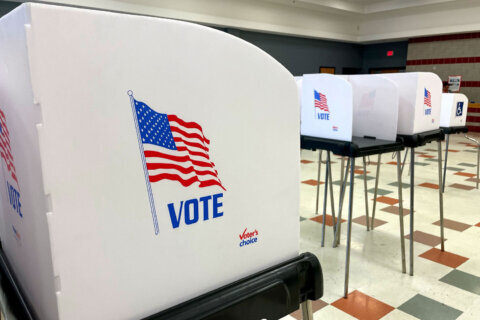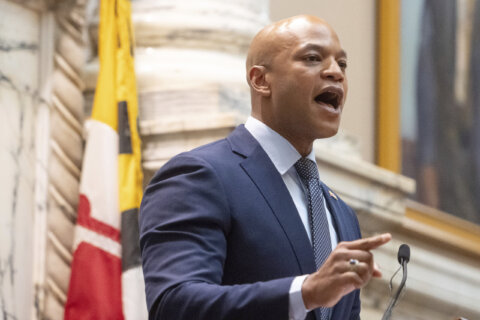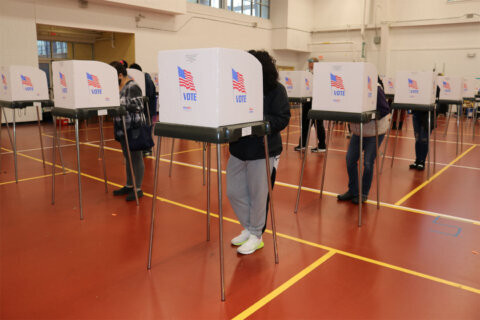This article was republished with permission from WTOP’s news partners at Maryland Matters. Sign up for Maryland Matters’ free email subscription today.
This content was republished with permission from WTOP’s news partners at Maryland Matters. Sign up for Maryland Matters’ free email subscription today.
The Board of Public Works appears poised to approve a contract Wednesday that would change the state’s longstanding vehicle emissions inspection program (VEIP), doubling the amount of time owners of new cars would need to get their first pollution test.
In interviews with reporters last week, the leaders of the Maryland Department of the Environment and the Motor Vehicle Administration cast the change, requiring new model cars to be tested after they’ve been on the road for six years rather than three, as a more efficient system as well as good for the environment. A vote to approve the contract would activate a regulation the administration of former Gov. Larry Hogan (R) put in place over the objections of the General Assembly.
The proposed contract, to increase funding for the current operator of the vehicle emissions test for the next year by about $1.5 million, while effectively reducing the number of annual inspections the company must make by about 30%, means the Moore administration is essentially ratifying the Hogan-era regulatory regime proposed several years ago.
Shortly after Gov. Wes Moore (D) took office in January, his administration paused a proposed procurement that the Hogan administration had been seeking as part of its desired regulatory change; officials at the time said they wanted to make sure the new regulation would be fair to all motorists and communities and wouldn’t just benefit owners of newer vehicles, who tend to be more prosperous than the population at large.
Whatever ultimately motivated the Moore administration to go along with the Hogan plan, there remain some unanswered questions about the new regulation and its impact.
For starters, MVA Administrator Christine Nizer told reporters last week that the new regulation requiring fewer vehicles to get emissions test would cost the state about $3 million in annual revenues.
But as it developed the regulation, the Hogan administration estimated in a filing published last fall in The Maryland Register that the loss of revenue would total about $2.3 million every six months — or $4.6 million annually. An analysis developed several weeks later by the Department of Legislative Services, which advises the General Assembly, suggested the proposed regulation could cost the state $6.1 million annually.
An MVA spokesperson did not respond to an email Friday seeking clarification on how much revenue the new regulation would cost the state, and if, how and why the agency’s estimates have been refined since the Maryland Register posting last year.
Three million dollars, Nizer’s latest declaration of lost revenue, isn’t that big in the overall scheme of the state government’s transportation spending — and neither is $6.1 million, the Department of Legislative Service’s estimate. But Maryland is facing a projected $4 billion shortfall in its Transportation Trust Fund, which pays for road and transit projects, over the next decade, and state leaders recently convened a new commission that will spend the next 18 months looking for ways to boost revenues for transportation spending. So even a few million dollars lost to the system is not insignificant in that context.
Maryland motorists in most counties have been taking their vehicles for emissions inspections for almost four decades. Most cars are required to be tested every two years. The inspections cost $14 if they’re done at testing centers, and they run $10 at self-service kiosks.
State officials last week noted that California doesn’t require new cars to be tested until they have been on the road for eight years. What they didn’t say is that California requires owners of newer cars to pay an annual “smog abatement fee” of between $20 and $25, depending on the age of the car. And much of that fee is used to help lower-income residents pay for their emissions test — or subsidize some of the repairs required for their cars to pass inspection.
The change in Maryland’s VEIP regulation required the state to establish Motorist Assistance Centers, which appear to be modeled on the California concept of helping motorists get the necessary repairs to pass the emissions test. According to the Maryland Register from Sept. 9, 2022, the centers are designed to “support motorists in acquiring effective emissions repairs so their vehicles will pass VEIP testing and maintain the improved emissions performance into the future. The Centers will provide motorists with access to an emissions repair specialist to help ensure that vehicles are repaired correctly and in a timely manner, enhancing both customer service and air quality benefits.”
But as they push the contract through the Board of Public Works to change the VEIP program, state officials have said nothing about the establishment of these Motorist Assistance Centers, and there does not appear to be any government funding set aside to get them going.
An MVA spokesperson did not respond to a request for comment on Friday.
Even if the BPW votes Wednesday to ratify the proposed contract, the new regulatory scheme does not automatically go into effect. Nizer told reporters last week that the contractor, Envirotest, would need a few weeks to retrofit the VEIP testing sites and make a few additional adjustments.
But first, the Maryland Department of the Environment is required to develop a plan on how it will implement the new rule and submit it to the U.S. Environmental Protection Agency for approval. Before submitting the plan to the federal government, the agency is required to hold a public hearing on the agency’s implementation plan for the new rule, which is taking place virtually on Sept. 18.







